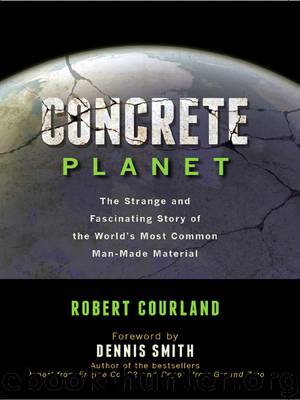Concrete Planet: The Strange and Fascinating Story of the World's Most Common Man-Made Material by Robert Courland

Author:Robert Courland [Courland, Robert]
Language: eng
Format: azw3
Publisher: Prometheus Books
Published: 2011-12-06T05:00:00+00:00
After the dissolution of the business relationship in Lägerdorf between Mr. Edward Fewer and myself, I can no longer bear any responsibility for the quality and worthiness of the cement that will henceforth be produced by Edward Fewer. Nor in the smallest degree may he associate my name with his brand. Itzehoe, July 9, 1863.52
It is almost comically ironic that “henceforth” (fortan) Edward Fewer's cement business would thrive.53
Aspdin, already a heavy drinker, drank more. One spring day in 1864, while walking down a street in Itzehoe—or perhaps stumbling along in a drunken stupor—he fell and most likely struck his head on a paving stone. He died soon thereafter, on April 11, 1864. He was forty-eight years old. William Aspdin lies buried in the town's Protestant cemetery.
Had he been an honest individual, Aspdin might have used his superior product to become the dominant player in the cement industry, enriching himself, his partners, and their shareholders. Instead, his serial swindling left nothing in its wake but ruined fortunes, estranged family members, and no one whom he might rightly call “friend” (there is no evidence that he ever owned a dog). One cannot but feel acute compassion for his wife and children, who disappeared from the public records in Germany and presumably moved back to England.
Upon his retirement in 1889, Edward Fewer sold his large and prosperous cement plant to the Alsen'sche Portland Cementfabrik. This would later become the international cement company Alsen, which is now part of the even larger Swiss firm Holcim, one of the largest concrete cement manufacturers in the world. Its success serves as an object lesson for “what might have been.” Had a virtuous version of William Aspdin existed in a parallel universe, he would have achieved more. And had this alternative Aspdin lived as long as Isaac Johnson, and then suffered the same mishap, he might have been killed by his own product.
So, did William Aspdin discover clinkering and, thus, true Portland cement? The research compiled by the esteemed British engineering historian Major A. C. Francis seems to suggest that credit should go—however grudgingly—to Joseph Aspdin's wayward son. I would tend to agree, but a curious discovery made several years ago presents us with a puzzle. In April 2008, archaeologists working at the dockyards in Bristol, England, uncovered the concrete floor of a factory building designed by Isambard Kingdom Brunel to manufacture the engines used for his ship, the SS Great Britain, the world's first propeller-driven, oceangoing vessel. After the Thames Tunnel was bricked up in 1828, Sir Marc Brunel's son shifted much of his attention to solving mechanical engineering challenges in the growing rail and shipping industries. (His contributions in these fields were substantial and later earned him a second-place position—Winston Churchill was first—in the BBC's program 100 Greatest Britons, which polled the UK public to determine the greatest people in British history.)54 The massive concrete floor using heavy aggregate, measures 20 m wide by 50 m long (ca. 66 ft by 164 ft) and 400 millimeters thick (ca.
Download
This site does not store any files on its server. We only index and link to content provided by other sites. Please contact the content providers to delete copyright contents if any and email us, we'll remove relevant links or contents immediately.
Learning SQL by Alan Beaulieu(6210)
Weapons of Math Destruction by Cathy O'Neil(6143)
Digital Minimalism by Cal Newport;(5664)
iGen by Jean M. Twenge(5366)
Sapiens by Yuval Noah Harari(5294)
The Age of Surveillance Capitalism by Shoshana Zuboff(4209)
Elon Musk by Ashlee Vance(4028)
Thing Explainer by Randall Munroe(3877)
Apollo 8 by Jeffrey Kluger(3637)
Future Crimes by Marc Goodman(3533)
The Science Book (Big Ideas Simply Explained) by DK(3233)
Who Can You Trust? by Rachel Botsman(3087)
Infinite Energy Technologies by Finley Eversole(2939)
I Live in the Future & Here's How It Works by Nick Bilton(2935)
The Innovators: How a Group of Hackers, Geniuses, and Geeks Created the Digital Revolution by Walter Isaacson(2836)
Steve Jobs by Walter Isaacson(2833)
Dawn of the New Everything by Jaron Lanier(2738)
Chernobyl by Serhii Plokhy(2497)
Ben Franklin's Almanac by Candace Fleming(2469)
